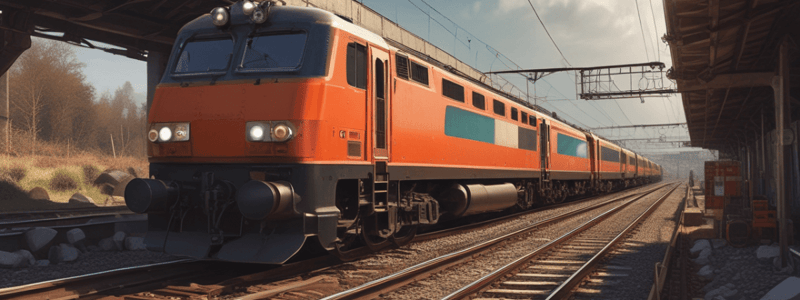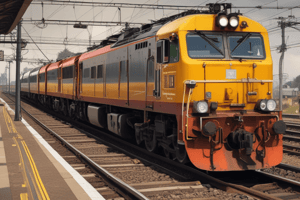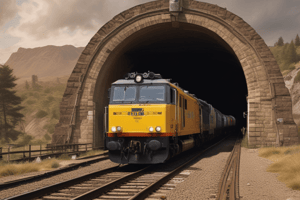Podcast
Questions and Answers
How many hose clips are required for thermit welding?
How many hose clips are required for thermit welding?
- 4 Nos. (correct)
- 2 Nos.
- 8 Nos.
- 6 Nos.
What is the size of the rail file mentioned in the content?
What is the size of the rail file mentioned in the content?
- 350 × 30 × 6 mm
- 350 × 40 × 6 mm (correct)
- 350 × 60 × 6 mm
- 350 × 50 × 6 mm
What is the purpose of the insulation hood for control cooling?
What is the purpose of the insulation hood for control cooling?
- For 110 UTS rail welding (correct)
- For grinding
- For crucible lining
- For welding
How many rail profile guided grinding trolleys are required?
How many rail profile guided grinding trolleys are required?
What is the expected life of the weld trimmer (cutter)?
What is the expected life of the weld trimmer (cutter)?
What should always be available for crucible lining?
What should always be available for crucible lining?
On what basis should the equipment be replaced if the expected life is not given?
On what basis should the equipment be replaced if the expected life is not given?
What should be followed as per the approved AT welding technique?
What should be followed as per the approved AT welding technique?
What is the purpose of providing SEJs at either end of a stretch of track?
What is the purpose of providing SEJs at either end of a stretch of track?
What is the primary requirement before laying LWR/CWR?
What is the primary requirement before laying LWR/CWR?
What is the purpose of a detailed plan in LWR/CWR?
What is the purpose of a detailed plan in LWR/CWR?
What is the typical scale of a detailed plan for LWR/CWR?
What is the typical scale of a detailed plan for LWR/CWR?
How many rail pieces are required for laying one LWR?
How many rail pieces are required for laying one LWR?
What is the purpose of fishplates in LWR/CWR?
What is the purpose of fishplates in LWR/CWR?
What is the purpose of rail closures in LWR/CWR?
What is the purpose of rail closures in LWR/CWR?
What is the purpose of de-stressing equipment in LWR/CWR?
What is the purpose of de-stressing equipment in LWR/CWR?
What is the primary cause of buckling of track?
What is the primary cause of buckling of track?
What is a sign of a track being subjected to undue strain?
What is a sign of a track being subjected to undue strain?
When should operations that impair lateral resistance be avoided?
When should operations that impair lateral resistance be avoided?
What is the purpose of a joint gap survey?
What is the purpose of a joint gap survey?
Why is it important to lubricate rail joints?
Why is it important to lubricate rail joints?
What is the result of inadequate expansion gaps in the track?
What is the result of inadequate expansion gaps in the track?
What can cause impairing of lateral resistance in the track?
What can cause impairing of lateral resistance in the track?
When should the greasing of fishplates be done?
When should the greasing of fishplates be done?
What should be removed before welding on an LWR?
What should be removed before welding on an LWR?
What is the purpose of creating a gap of 1 m at location 'B'?
What is the purpose of creating a gap of 1 m at location 'B'?
What determines the anchor length 'la'?
What determines the anchor length 'la'?
Why should the anchor length be increased?
Why should the anchor length be increased?
What is the purpose of marking distances W0 W1, etc.?
What is the purpose of marking distances W0 W1, etc.?
What happens when tP is less than the desired to?
What happens when tP is less than the desired to?
What is done to the portion from A2 C2 during de-stressing?
What is done to the portion from A2 C2 during de-stressing?
What is the purpose of de-stressing?
What is the purpose of de-stressing?
Who is responsible for performing detailed calculations to ascertain the effect of LWR on bridges with ballasted deck?
Who is responsible for performing detailed calculations to ascertain the effect of LWR on bridges with ballasted deck?
What is the condition for permitting LWR/CWR on bridges with ballasted deck?
What is the condition for permitting LWR/CWR on bridges with ballasted deck?
What type of fastenings are required for bridges with un-ballasted deck?
What type of fastenings are required for bridges with un-ballasted deck?
What is the maximum length of the bridge that does not exceed the stipulations in Table-1?
What is the maximum length of the bridge that does not exceed the stipulations in Table-1?
What is the purpose of providing PRC sleepers with elastic rail clips on the approach track?
What is the purpose of providing PRC sleepers with elastic rail clips on the approach track?
What is the location of the SEJ of the LWR in relation to the bridge?
What is the location of the SEJ of the LWR in relation to the bridge?
What is the condition for the ballast section of the approach track?
What is the condition for the ballast section of the approach track?
What is the length of the approach track that should be well-anchored by providing PRC sleepers with elastic rail clips?
What is the length of the approach track that should be well-anchored by providing PRC sleepers with elastic rail clips?
Flashcards are hidden until you start studying
Study Notes
Thermit Welding Team Equipment
- Hose clips: 4 Nos.
- Pliers: 1 No.
- Rail file: 350 × 40 × 6 mm (For Emergency use only), 4 Nos.
- Weld trimmer (Cutter): 1 No.
- Insulation hood for control cooling: 1 No.
- Rail profile guided grinding trolley (Grinding wheel): 1 No.
- Protective clothing, shoes gear, and Leather gloves: must be available to ensure quality.
Composition of Thermit Welding Team
- The team should have specific equipment, including compressor tank-wise, depending on the requirement.
Laying Long Welded Rails (LWR)
- Materials required: • 4 metre or longer rail pieces of the same rail section as LWR • 2 sets of SEJs with sleepers and fastenings • Adequate numbers of 1 metre long fishplates with special screw clamps/joggled fishplates with slotted grooves and bolted clamps • Rail closures of suitable sizes • 1 metre and 10 cm straight edges • Callipers and feeler gauges (2 mm to 0.1 mm) • Rail cutting equipment • De-stressing equipment
Buckling of Track
- Buckling occurs when high compressive forces are created in the rails due to inadequacy of lateral resistance in the track.
- Conditions that induce buckling: • Inadequate expansion gaps • Failure to counteract creep in time • Non-lubrication of rail joints
- Precautions against buckling: • Avoid operations that impair lateral resistance during high rail temperatures • Grease fishplates before hot weather • Adjust joint gaps in SWR and free rail track before hot weather
Bridges with Ballasted Deck (with bearing)
- Detailed calculations are required by the Design office to ascertain the effect of LWR on bridges and their sub-structure.
- LWR/CWR may be permitted on a case-to-case basis based on calculations.
Bridges with Un-Ballasted Deck
- LWR/CWR shall be continued over bridges with specific overall lengths and conditions.
De-stressing with Rail Tensors
- Procedure for de-stressing of LWR with rail tensor: • De-stress in parts if LWR is longer than manageable lengths • Remove impediments to free movement of rail • Create a gap of 1 m at the centre of the first segment of the LWR • Mark anchor length and transfer marks onto the rail foot • De-stress operation shall be carried out when tP is less than the desired to
Studying That Suits You
Use AI to generate personalized quizzes and flashcards to suit your learning preferences.




